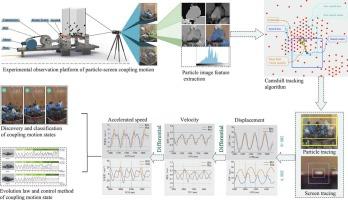Experimental study on the coupled motion of Flip-flow screen plate and granular materials based on target tracking technology
IF 4.6
2区 工程技术
Q2 ENGINEERING, CHEMICAL
引用次数: 0
Abstract
The flip-flow screen is widely applied in dry deep screening processes across various industrial sectors. However, limitations in understanding the motion mechanisms of large-deformation screen plates and material particle groups hinder its further optimization and broader application. Therefore, an experimental platform was constructed to observe the coupled motion, utilizing high-speed imaging and target tracking algorithms to monitor the motion of both materials and the screen plate. The accuracy of the tracking results was validated through comparison with acceleration measurement system data. The study identified the evolutionary patterns of coupled motion states under varying driving frequencies. By analyzing the displacement, velocity, and acceleration of both particles and the screen plate, it was revealed the mechanisms underlying these different motion states. Additionally, the effects of material load and screen tension on the evolution of particle motion states were examined, clarifying the regulation methods of coupled motion states. Results indicate that with a material load of 4 kg and a driving amplitude of 6 mm, within a driving frequency range of 1.5 Hz to 15 Hz, the material particles and the screen plate sequentially exhibit relative static, synchronous periodic motion, period-doubling motion, chaotic motion, and inert motion. Among these states, chaotic motion promotes greater particle activity, benefiting material loosening and segregation. Within the 6 Hz to 15 Hz driving frequency range, reducing the material load or increasing screen tension facilitates the occurrence of chaotic motion. These findings provide valuable insights for the improved application and optimization of flip-flow screens.

基于目标跟踪技术的转流筛板与颗粒物料耦合运动实验研究
倒转流筛广泛应用于各种工业部门的干式深度筛分过程。然而,对大变形筛板和材料颗粒群运动机理的认识有限,阻碍了其进一步优化和广泛应用。为此,搭建了观察耦合运动的实验平台,利用高速成像和目标跟踪算法同时监测材料和筛板的运动。通过与加速度测量系统数据的对比,验证了跟踪结果的准确性。研究确定了不同驱动频率下耦合运动状态的演化模式。通过分析颗粒和筛板的位移、速度和加速度,揭示了这些不同运动状态的机制。此外,还研究了材料载荷和筛网张力对颗粒运动状态演变的影响,阐明了耦合运动状态的调节方法。结果表明,当物料载荷为4 kg,驱动幅值为6 mm时,在1.5 ~ 15 Hz的驱动频率范围内,物料颗粒和筛板依次表现为相对静态、同步周期运动、倍周期运动、混沌运动和惰性运动。在这些状态中,混沌运动促进更大的粒子活动,有利于材料松动和偏析。在6hz ~ 15hz驱动频率范围内,降低物料负荷或增大筛网张力有利于混沌运动的发生。这些发现为改进反流式筛管的应用和优化提供了有价值的见解。
本文章由计算机程序翻译,如有差异,请以英文原文为准。
求助全文
约1分钟内获得全文
求助全文
来源期刊

Powder Technology
工程技术-工程:化工
CiteScore
9.90
自引率
15.40%
发文量
1047
审稿时长
46 days
期刊介绍:
Powder Technology is an International Journal on the Science and Technology of Wet and Dry Particulate Systems. Powder Technology publishes papers on all aspects of the formation of particles and their characterisation and on the study of systems containing particulate solids. No limitation is imposed on the size of the particles, which may range from nanometre scale, as in pigments or aerosols, to that of mined or quarried materials. The following list of topics is not intended to be comprehensive, but rather to indicate typical subjects which fall within the scope of the journal's interests:
Formation and synthesis of particles by precipitation and other methods.
Modification of particles by agglomeration, coating, comminution and attrition.
Characterisation of the size, shape, surface area, pore structure and strength of particles and agglomerates (including the origins and effects of inter particle forces).
Packing, failure, flow and permeability of assemblies of particles.
Particle-particle interactions and suspension rheology.
Handling and processing operations such as slurry flow, fluidization, pneumatic conveying.
Interactions between particles and their environment, including delivery of particulate products to the body.
Applications of particle technology in production of pharmaceuticals, chemicals, foods, pigments, structural, and functional materials and in environmental and energy related matters.
For materials-oriented contributions we are looking for articles revealing the effect of particle/powder characteristics (size, morphology and composition, in that order) on material performance or functionality and, ideally, comparison to any industrial standard.
 求助内容:
求助内容: 应助结果提醒方式:
应助结果提醒方式:


